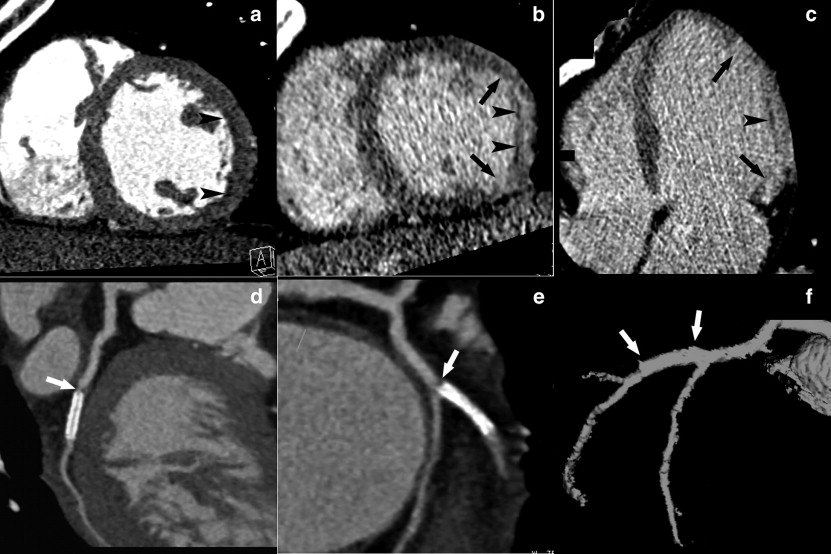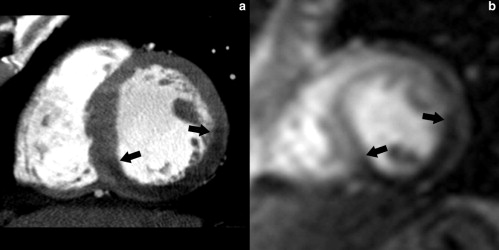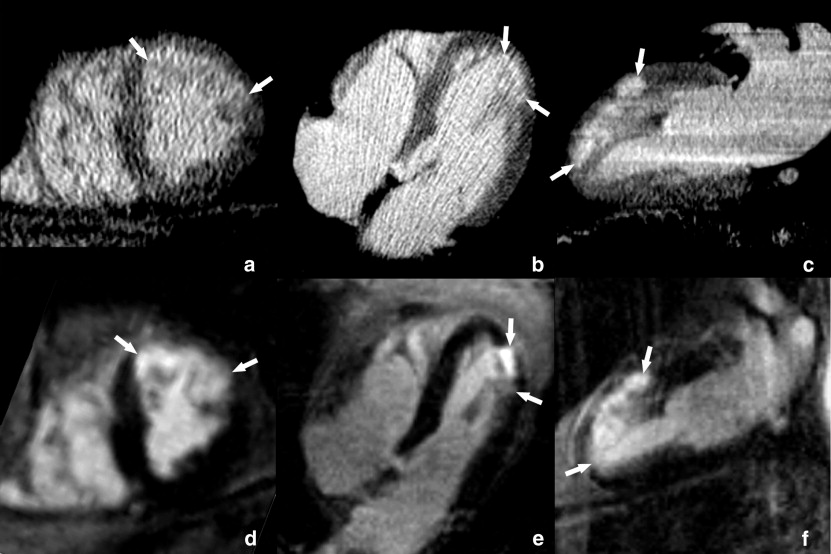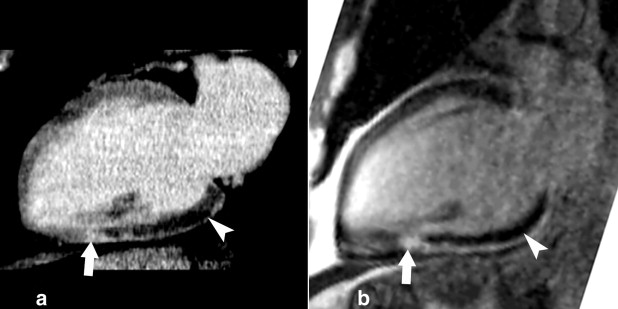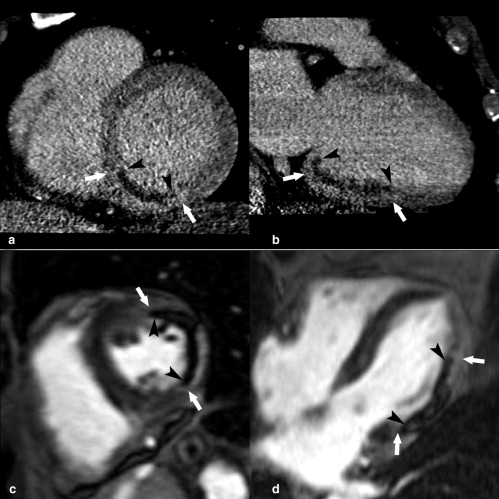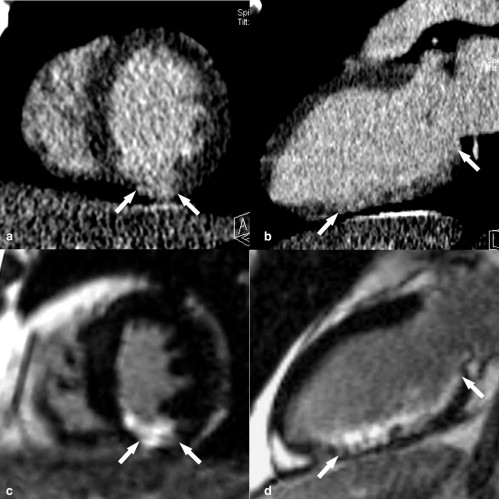Rationale and Objectives
Despite the progress made in diagnosis and treatment, cardiovascular diseases remain the main cause of death worldwide.
Materials and Methods
Multidetector row computed tomography (MDCT) provides several diagnostic insights, namely assessment of coronary artery anatomy and measurement of left ventricular volume and function. The ability of CT to show myocardial infarcted areas as an enhanced territory was described in the late 1970s in an animal model.
Results
This method found a second wind with the arrival of MDCT technology that led to its clinical application. Several authors describe the ability of MDCT to assess myocardial injury both in animals and humans. The MDCT assessment of myocardial late enhancement is based on the same principle as delayed enhancement MRI.
Conclusions
The aim of this review is to cover the technical aspects of cardiac MDCT in assessing the myocardium and its potential in diagnosing ischemic heart disease.
Traditionally electrocardiography, nuclear imaging, stress echocardiography, and, more recently, magnetic resonance imaging (MRI), have been the clinical mainstays for assessing ischemic heart disease. However, modern multidetector row computed tomography (MDCT) is an emerging noninvasive imaging technology that provides high-resolution three-dimensional images of the heart and coronary artery. MDCT provides several diagnostic insights that can be obtained separately or in various combinations during a patient examination. For example, MDCT can be used to assess the anatomy of the coronary arteries and cardiac chambers ( ), left ventricular volumes and function ( ), myocardial tissue injury ( ), and myocardial perfusion ( ).
A current state of the art MDCT scanner acquires 64 channels of data with a detector width of 0.5 or 0.6 mm. The fastest rotation time is 330 milliseconds, which results in a temporal resolution of 165 milliseconds with a 180° reconstruction algorithm ( ). The scan time has decreased from 40 seconds for the first MDCT generation to less than 10 seconds with the 64-slice technologies. Recently, dual-source CT was introduced, with an improvement in temporal resolution (83 milliseconds) ( ). Scanners with more detectors that cover the entire heart are now being developed, which may abolish the need for a moving table. Cardiac MRI remains the gold standard technique for viability assessment and infarct characterization and will be used as such in this article. The aim of this review is to cover the technical aspects of cardiac MDCT in assessing the myocardium and its potential in diagnosing ischemic heart disease.
Principles of myocardial late enhancement
Get Radiology Tree app to read full this article<
Technical aspects
Image Acquisition
Get Radiology Tree app to read full this article<
Acquisition Phase
Get Radiology Tree app to read full this article<
Get Radiology Tree app to read full this article<
Get Radiology Tree app to read full this article<
Acquisition Parameters
Get Radiology Tree app to read full this article<
Get Radiology Tree app to read full this article<
Get Radiology Tree app to read full this article<
Contrast Injection
Get Radiology Tree app to read full this article<
Get Radiology Tree app to read full this article<
Clinical applications and perspectives
Myocardial Characterization on Arterial Rule-out Phase
Get Radiology Tree app to read full this article<
Get Radiology Tree app to read full this article<
Get Radiology Tree app to read full this article<
Myocardial Characterization on Tissue Rule-out Phase
Get Radiology Tree app to read full this article<
Get Radiology Tree app to read full this article<
Get Radiology Tree app to read full this article<
Get Radiology Tree app to read full this article<
Get Radiology Tree app to read full this article<
Get Radiology Tree app to read full this article<
Get Radiology Tree app to read full this article<
Myocardial Viability Assessment
Get Radiology Tree app to read full this article<
Myocardial Perfusion Assessment
Get Radiology Tree app to read full this article<
Get Radiology Tree app to read full this article<
Advantages and drawbacks
Advantages of MDCT Over MR Imaging
Get Radiology Tree app to read full this article<
Table 1
Comparison Between Myocardial Ischemic Disease Characterization Using Dual Source Computed Tomography (DSCT) and MRI
DSCT MRI Claustrophobia risk No Yes (3%–6%) Contraindication if pace maker or implantable defibrillator No Yes Coronary anatomy assessment Yes Not in clinical routine LV function assessment Yes Yes Contrast media Iodine Gadolinium Toxicity of contrast media Renal failure, allergy Nephrogenic systemic fibrosis [contrast media] and signal Linear relationship Nonlinear relationship Spatial resolution 0.4 mm isotropic 1.2 mm anisotropic Contrast resolution = +++ Temporal resolution enhancement 83 milliseconds 100 milliseconds for late X-ray Yes No Exam duration 10 minutes 30–45 minutes Cost + ++
Get Radiology Tree app to read full this article<
Radiation Exposure During Cardiac CT
Get Radiology Tree app to read full this article<
Conclusion
Get Radiology Tree app to read full this article<
References
1. Hendel R.C., Patel M.R., Kramer C.M., et. al.: ACCF/ACR/SCCT/SCMR/ASNC/NASCI/SCAI/SIR 2006 appropriateness criteria for cardiac computed tomography and cardiac magnetic resonance imaging: a report of the American College of Cardiology Foundation Quality Strategic Directions Committee Appropriateness Criteria Working Group, American College of Radiology, Society of Cardiovascular Computed Tomography, Society for Cardiovascular Magnetic Resonance, American Society of Nuclear Cardiology, North American Society for Cardiac Imaging, Society for Cardiovascular Angiography and Interventions, and Society of Interventional Radiology. J Am Coll Cardiol 2006; 48: pp. 1475-1497.
2. van der Vleuten P.A., Wille T.P., Gotte M.J., et. al.: Quantification of global left ventricular function: comparison of multidetector computed tomography and magnetic resonance imaging. a meta-analysis and review of the current literature. Acta Radiol 2006; 47: pp. 1049-1057.
3. Gerber B.L., Belge B., Legros G.J., et. al.: Characterization of acute and chronic myocardial infarcts by multidetector computed tomography: comparison with contrast-enhanced magnetic resonance. Circulation 2006; 113: pp. 823-833.
4. Lardo A.C., Cordeiro M.A., Silva C., et. al.: Contrast-enhanced multidetector computed tomography viability imaging after myocardial infarction: characterization of myocyte death, microvascular obstruction, and chronic scar. Circulation 2006; 113: pp. 394-404.
5. George R.T., Silva C., Cordeiro M.A., et. al.: Multidetector computed tomography myocardial perfusion imaging during adenosine stress. J Am Coll Cardiol 2006; 48: pp. 153-160.
6. Mahnken A.H., Bruners P., Katoh M., et. al.: Dynamic multi-section CT imaging in acute myocardial infarction: preliminary animal experience. Eur Radiol 2006; 16: pp. 746-752.
7. Cademartiri F., Schuijf J.D., Pugliese F., et. al.: Usefulness of 64-slice multislice computed tomography coronary angiography to assess in-stent restenosis. J Am Coll Cardiol 2007; 49: pp. 2204-2210.
8. Johnson T.R., Nikolaou K., Wintersperger B.J., et. al.: Dual-source CT cardiac imaging: initial experience. Eur Radiol 2006; 16: pp. 1409-1415.
9. Mattrey R.F., Higgins C.B.: 1982 Memorial Award Paper. Invest Radiol 1982; 17: pp. 329-335.
10. Newell J.D., Higgins C.B., Abraham J.L., et. al.: Computerized tomographic appearance of evolving myocardial infarctions. Invest Radiol 1980; 15: pp. 207-214.
11. Siemers P.T., Higgins C.B., Schmidt W., et. al.: Detection, quantitation and contrast enhancement of myocardial infarction utilizing computerized axial tomography: comparison with histochemical staining and 99mTc-pyrophosphate imaging. Invest Radiol 1978; 13: pp. 103-109.
12. Habis M., Capderou A., Ghostine S., et. al.: Acute myocardial infarction early viability assessment by 64-slice computed tomography immediately after coronary angiography: comparison with low-dose dobutamine echocardiography. J Am Coll Cardiol 2007; 49: pp. 1178-1185.
13. Mahnken A.H., Koos R., Katoh M., et. al.: Assessment of myocardial viability in reperfused acute myocardial infarction using 16-slice computed tomography in comparison to magnetic resonance imaging. J Am Coll Cardiol 2005; 45: pp. 2042-2047.
14. Higgins C.B., Sovak M., Schmidt W., et. al.: Uptake of contrast materials by experimental acute myocardial infarctions: a preliminary report. Invest Radiol 1978; 13: pp. 337-339.
15. Weinmann H.J., Brasch R.C., Press W.R., et. al.: Characteristics of gadolinium-DTPA complex: a potential NMR contrast agent. AJR Am J Roentgenol 1984; 142: pp. 619-624.
16. Saeed M., Higgins C.B., Geschwind J.F., et. al.: T1-relaxation kinetics of extracellular, intracellular and intravascular MR contrast agents in normal and acutely reperfused infarcted myocardium using echo-planar MR imaging. Eur Radiol 2000; 10: pp. 310-318.
17. Kim R.J., Chen E.L., Lima J.A., et. al.: Myocardial Gd-DTPA kinetics determine MRI contrast enhancement and reflect the extent and severity of myocardial injury after acute reperfused infarction. Circulation 1996; 94: pp. 3318-3326.
18. Arheden H., Saeed M., Higgins C.B., et. al.: Measurement of the distribution volume of gadopentetate dimeglumine at echo-planar MR imaging to quantify myocardial infarction: comparison with 99mTc-DTPA autoradiography in rats. Radiology 1999; 211: pp. 698-708.
19. Arheden H., Saeed M., Higgins C.B., et. al.: Reperfused rat myocardium subjected to various durations of ischemia: estimation of the distribution volume of contrast material with echo-planar MR imaging. Radiology 2000; 215: pp. 520-528.
20. Judd R.M., Lugo-Olivieri C.H., Arai M., et. al.: Physiological basis of myocardial contrast enhancement in fast magnetic resonance images of 2-day-old reperfused canine infarcts. Circulation 1995; 92: pp. 1902-1910.
21. Dambrin G., Laissy J.P., Serfaty J.M., et. al.: Diagnostic value of ECG-gated multidetector computed tomography in the early phase of suspected acute myocarditis. Eur Radiol 2007; 17: pp. 331-338.
22. Budoff M.J., Achenbach S., Blumenthal R.S., et. al.: Assessment of coronary artery disease by cardiac computed tomography: a scientific statement from the American Heart Association Committee on Cardiovascular Imaging and Intervention, Council on Cardiovascular Radiology and Intervention, and Committee on Cardiac Imaging, Council on Clinical Cardiology. Circulation 2006; 114: pp. 1761-1791.
23. Baks T., Cademartiri F., Moelker A.D., et. al.: Multislice computed tomography and magnetic resonance imaging for the assessment of reperfused acute myocardial infarction. J Am Coll Cardiol 2006; 48: pp. 144-152.
24. Brodoefel H., Reimann A., Klumpp B., et. al.: Assessment of myocardial viability in a reperfused porcine model: evaluation of different MSCT contrast protocols in acute and subacute infarct stages in comparison with MRI. J Comput Assist Tomogr 2007; 31: pp. 290-298.
25. Buecker A., Katoh M., Krombach G.A., et. al.: A feasibility study of contrast enhancement of acute myocardial infarction in multislice computed tomography: comparison with magnetic resonance imaging and gross morphology in pigs. Invest Radiol 2005; 40: pp. 700-704.
26. Hoffmann U., Nagurney J.T., Moselewski F., et. al.: Coronary multidetector computed tomography in the assessment of patients with acute chest pain. Circulation 2006; 114: pp. 2251-2260.
27. Mollet N.R., Cademartiri F., van Mieghem C.A., et. al.: High-resolution spiral computed tomography coronary angiography in patients referred for diagnostic conventional coronary angiography. Circulation 2005; 112: pp. 2318-2323.
28. Koyama Y., Matsuoka H., Mochizuki T., et. al.: Assessment of reperfused acute myocardial infarction with two-phase contrast-enhanced helical CT: prediction of left ventricular function and wall thickness. Radiology 2005; 235: pp. 804-811.
29. Paul J.F., Wartski M., Caussin C., et. al.: Late defect on delayed contrast-enhanced multi-detector row CT scans in the prediction of SPECT infarct size after reperfused acute myocardial infarction: initial experience. Radiology 2005; 236: pp. 485-489.
30. Mahnken A.H., Bruners P., Muhlenbruch G., et. al.: Low tube voltage improves computed tomography imaging of delayed myocardial contrast enhancement in an experimental acute myocardial infarction model. Invest Radiol 2007; 42: pp. 123-129.
31. Brodoefel H., Klumpp B., Reimann A., et. al.: Late myocardial enhancement assessed by 64-MSCT in reperfused porcine myocardial infarction: diagnostic accuracy of low-dose CT protocols in comparison with magnetic resonance imaging. Eur Radiol 2007; 17: pp. 475-483.
32. Boll D.T., Hoffmann M.H., Huber N., et. al.: Spectral coronary multidetector computed tomography angiography: dual benefit by facilitating plaque characterization and enhancing lumen depiction. J Comput Assist Tomogr 2006; 30: pp. 804-811.
33. Simon G.H., Fu Y., Berejnoi K., et. al.: Initial computed tomography imaging experience using a new macromolecular iodinated contrast medium in experimental breast cancer. Invest Radiol 2005; 40: pp. 614-620.
34. Mahnken A.H., Bruners P., Kinzel S., et. al.: Late-phase MSCT in the different stages of myocardial infarction: animal experiments. Eur Radiol 2007; 17: pp. 2310-2317.
35. Nikolaou K., Knez A., Sagmeister S., et. al.: Assessment of myocardial infarctions using multidetector-row computed tomography. J Comput Assist Tomogr 2004; 28: pp. 286-292.
36. Sanz J., Weeks D., Nikolaou K., et. al.: Detection of healed myocardial infarction with multidetector-row computed tomography and comparison with cardiac magnetic resonance delayed hyperenhancement. Am J Cardiol 2006; 98: pp. 149-155.
37. Saeed M., Lee R.J., Weber O., et. al.: Scarred myocardium imposes additional burden on remote viable myocardium despite a reduction in the extent of area with late contrast MR enhancement. Eur Radiol 2006; 16: pp. 827-836.
38. Croisille P., Revel D., Saeed M.: Contrast agents and cardiac MR imaging of myocardial ischemia: from bench to bedside. Eur Radiol 2006; 16: pp. 1951-1963.
39. Gerber K.H., Higgins C.B.: Quantitation of size of myocardial infarctions by computerized transmission tomography. Invest Radiol 1983; 18: pp. 238-244.
40. Higgins C.B., Hagen P.L., Newell J.D., et. al.: Contrast enhancement of myocardial infarction: dependence on necrosis and residual blood flow and the relationship to distribution of scintigraphic imaging agents. Circulation 1982; 65: pp. 739-746.
41. Baks T., Cademartiri F., Moelker A.D., et. al.: Assessment of acute reperfused myocardial infarction with delayed enhancement 64-MDCT. AJR Am J Roentgenol 2007; 188: pp. W135-W137.
42. Hoffmann U., Millea R., Enzweiler C., et. al.: Acute myocardial infarction: contrast-enhanced multi-detector row CT in a porcine model. Radiology 2004; 231: pp. 697-701.
43. Saeed M., Wendland M.F., Yu K.K., et. al.: Identification of myocardial reperfusion with echo planar magnetic resonance imaging. Circulation 1994; 90: pp. 1492-1501.
44. Lessick J., Dragu R., Mutlak D., et. al.: Is functional improvement after myocardial infarction predicted with myocardial enhancement patterns at multidetector CT?. Radiology 2007; 244: pp. 736-744.
45. Jaschke W., Gould R.G., Assimakopoulos P.A., et. al.: Flow measurements with a high-speed computed tomography scanner. Med Phys 1987; 14: pp. 238-243.
46. Gould R.G., Lipton M.J., McNamara M.T., et. al.: Measurement of regional myocardial blood flow in dogs by ultrafast CT. Invest Radiol 1988; 23: pp. 348-353.
47. Nickoloff E.L., Alderson P.O.: A comparative study of thoracic radiation doses from 64-slice cardiac CT. Br J Radiol 2007; 80: pp. 537-544.
48. Paul J.F., Abada H.T.: Strategies for reduction of radiation dose in cardiac multislice CT. Eur Radiol 2007; 17: pp. 2028-2037.
